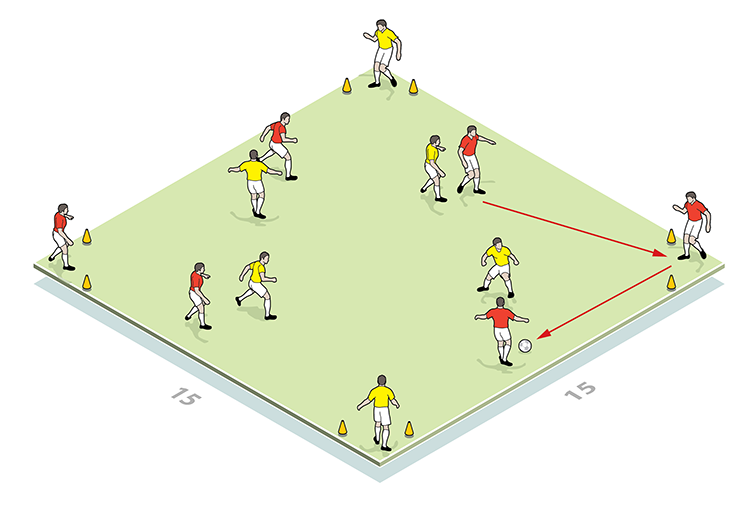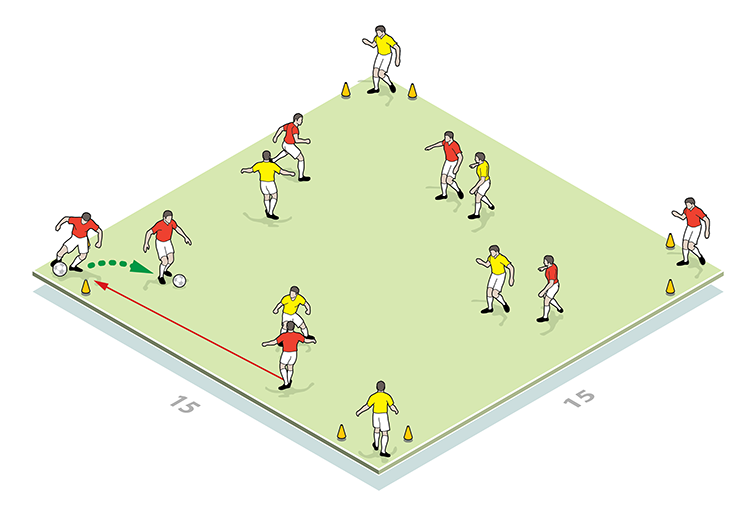Small-sided games provide the best foundation for players when looking for them to rehearse the key technical and tactical elements that are taught in training.

| Area | Up to a half pitch |
| Equipment | Balls, cones, goals |
| No. of Players | Up to 18 |
| Session Time | Corner game and progressions 28mins, Long game 15mins, Half-pitch game 15mins |
Small-sided games provide the best foundation for players when looking for them to rehearse the key technical and tactical elements that are taught in training.
They help us practise communication, passing, movement off the ball and tackling, and this session is comprised of three games which enable the players to progress from one concept to the next.
We’ll always finish sessions with small-sided games to retain a competitive element in training, which is so important.
What do I get the players to do?
Corner game
Set up as shown – 4v4 in the middle with two players from each team positioned in corners.
Both teams compete for possession, which must be maintained with sharp passing and constant movement. A point is awarded for passing to a corner player and receiving a return pass (1). If this goes to another man play continues, but a point isn’t awarded. Play for 3x3mins, rotating so each player goes into the corner.
1

How do I progress the game?
Now a corner player returns the pass to a different team mate (2) – play for another 3x3mins. Next, he swaps position with the player who made the pass (3) – play for 10mins.
2

3

What are the key things to look out for technically/tactically?
We’re looking for quick ball movement, efficient one- and two-touch play, good communication and awareness, and an appreciation of the right angle and distance at which to support.
Long game
Setting up as shown, teams compete for possession of the ball. Each can utilise the wide floaters at any time, who are two-touch. A point is scored by successfully dribbling into an end zone. The team then turns and attacks the other end. If the ball goes out of play, restart with the coach.
How do I progress the game?
One- or two-touch target players are added to end zones. A point is awarded for passing to a target player, receiving the return pass, then dribbling into the end zone (4). Progress again whereby the target man’s ball cannot be to the player who made the incoming pass (5).
4

5

Half-pitch game
Set up as shown, 8v4 inside the central area, with four target players (defenders) on outer cones. There is a keeper in each goal.
The coach feeds an attacker who, with his team mates, attempts to complete 10 passes, one- or two-touch. On the tenth pass, an attacker can burst out of the area for an effort on goal (6). If defenders win possession, they make a pass to any target player, for a point. After an unsuccessful shot or loss of possession the next ball (of six in total) is played in.
6

Editor's Picks
Attacking transitions
Deep runs in the final third
Using the goalkeeper in build-up play
Intensive boxes drill with goals
Penetrating the final third
Creating and finishing
My philosophy
Pressing initiation
Compact team movement
Coaches' Testimonials
Coaches' Testimonials
Join the world's leading coaches and managers and discover for yourself one of the best kept secrets in coaching. No other training tool on the planet is written or read by the calibre of names you’ll find in Elite Soccer.
In a recent survey 92% of subscribers said Elite Soccer makes them more confident, 89% said it makes them a more effective coach and 91% said it makes them more inspired.
Get Monthly Inspiration
All the latest techniques and approaches
Since 2010 Elite Soccer has given subscribers exclusive insight into the training ground practices of the world’s best coaches. Published in partnership with the League Managers Association we have unparalleled access to the leading lights in the English leagues, as well as a host of international managers.
Elite Soccer exclusively features sessions written by the coaches themselves. There are no observed sessions and no sessions “in the style of”, just first-hand advice delivered direct to you from the coach.























